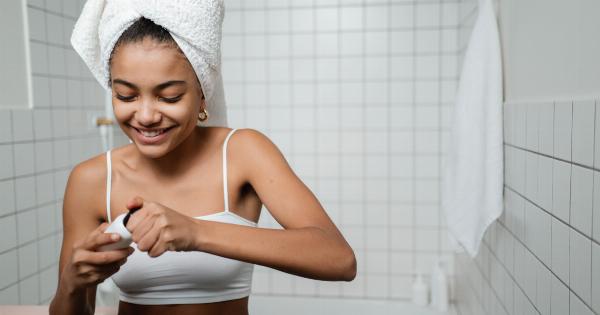Ingrown hair can be a frustrating and uncomfortable condition to deal with. They occur when a hair shaft grows back into the skin, causing inflammation and sometimes infection.
While ingrown hairs can affect anyone, they are more common in individuals with curly or coarse hair. Luckily, there are several effective methods to remove ingrown hair safely and prevent future occurrences. In this article, we will discuss the right techniques to eliminate ingrown hair and promote healthier and smoother skin.
1. Exfoliation is Key
Exfoliating the affected area is crucial when it comes to getting rid of ingrown hair. Regular exfoliation eliminates dead skin cells and unclogs pores, allowing the hair to break through the skin’s surface.
By removing dead skin cells, exfoliation also helps prevent the hair from curling back into the skin. There are several exfoliation options available, such as:.
– Using a gentle scrub or exfoliating brush to cleanse the area.
– Applying chemical exfoliants like salicylic acid or glycolic acid.
– Dry brushing to stimulate blood circulation and remove dead skin cells.
Choose the method that suits your skin type and preferences. However, make sure not to over-exfoliate, as excessive scrubbing can irritate the skin and worsen the condition.
2. Soften the Area
Sometimes, the hair becomes trapped under a layer of dead skin, making it difficult to remove. To counter this, you can apply a warm compress to the affected area.
Soaking a cloth in warm water and placing it on the ingrown hair for a few minutes can help soften the skin and prepare it for hair removal. The warmth will open up the pores, making it easier to extract the hair.
3. Use a Sterilized Needle or Tweezers
Before proceeding, ensure that your needle or tweezers are sterilized to prevent any infection. You can do this by cleaning them with rubbing alcohol or boiling them in water.
Once you have sterilized your tools, gently lift the tip of the ingrown hair with the needle or tweezers, taking care not to dig deep into the skin. Once the hair is visible, you can slide it out gently using a circular motion. Remember to avoid plucking the hair forcefully, as this can cause further irritation.
4. Apply Hydrocortisone Cream
After successfully removing the ingrown hair, the affected area may still exhibit some redness and inflammation. Applying over-the-counter hydrocortisone cream can help reduce these symptoms.
Hydrocortisone is a mild steroid that effectively calms irritated skin and minimizes redness. Remember to follow the instructions on the packaging and avoid using hydrocortisone cream on open wounds or broken skin.
5. Avoid Tight Clothing
Wearing tight clothing, especially in areas prone to ingrown hair, increases friction and traps sweat and dead skin cells. This can exacerbate the problem and lead to more ingrown hairs.
Opt for loose-fitting clothes made from breathable fabrics to prevent further irritation and allow the skin to breathe.
6. Moisturize Daily
Keeping the affected area moisturized is crucial for preventing future ingrown hairs. Dry skin can worsen the condition and make it easier for the hair to grow back into the skin.
Choose a non-comedogenic moisturizer that is suitable for your skin type and apply it daily. Moisturizers containing ingredients like tea tree oil or witch hazel can also provide additional benefits due to their anti-inflammatory and antibacterial properties.
7. Avoid Shaving Too Closely
One common cause of ingrown hair is shaving too closely or against the direction of hair growth. This can cause the hair to be cut too short, making it more likely to grow back into the skin.
To minimize the risk of ingrown hairs, shave in the direction of hair growth using a sharp, clean razor. Additionally, try not to repeatedly go over the same area as this can lead to irritation.
8. Consider Hair Removal Alternatives
If you frequently experience ingrown hairs from traditional methods of hair removal, such as shaving or waxing, you may want to explore alternative options.
Laser hair removal and electrolysis are two long-lasting methods that can reduce the occurrence of ingrown hairs. These treatments target hair follicles, inhibiting hair growth, and minimizing the chance of ingrown hairs.
9. Practice Good Hygiene
Maintaining good hygiene is essential for preventing and treating ingrown hairs. Make sure to keep the affected area clean and dry. Avoid touching the area with dirty hands or introducing bacteria by sharing towels or clothing.
Practicing good hygiene can reduce the risk of infection and promote faster healing.
10. Consult a Dermatologist
If you have tried various methods to remove ingrown hair without success or have frequent ingrown hairs that cause severe discomfort, it may be time to consult a dermatologist.
A dermatologist can examine your condition, provide personalized advice, and offer advanced treatment options if necessary.
Overall, removing ingrown hair requires a careful and strategic approach. By exfoliating regularly, using sterile tools, and following proper aftercare, you can effectively eliminate ingrown hair and prevent future occurrences.
Remember to be patient and gentle while treating ingrown hairs to avoid further skin damage. By incorporating these methods into your skincare routine, you can achieve smoother, blemish-free skin.































